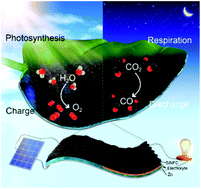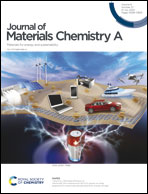A photovoltaic-driven solid-state Zn–CO2 electrochemical cell system with sunlight-insusceptible chemical production†
Abstract
Artificial leaves conduct photo(electro)chemical reactions for chemical and fuel production directly driven by sunlight/photovoltaic cells. Therefore, only in the presence of real-time sunlight can artificial leaves generate chemicals and fuels, limiting the prolonged production and flexible application of artificial leaves. In this work, by simply coupling a photovoltaic cell with a solid-state Zn–CO2 electrochemical cell as a new conceptual artificial leaf, continuous chemical production not only with sunlight but also in the dark was realized. In this conceptual artificial leaf, photo-generated electricity from the photovoltaic cell was pre-stored in the electrochemical cell during charge and CO2 reduction occurred in discharge. With pure CO2 supply, the conceptual artificial leaf achieved a solar-to-CO efficiency up to 15.2%, which surpassed that of the record artificial leaves and was among the highest efficiencies for artificial photosynthesis devices. This work provides possibilities for developing more universal-applied artificial leaves producing chemicals and fuels with ever-changing sunlight.



 Please wait while we load your content...
Please wait while we load your content...